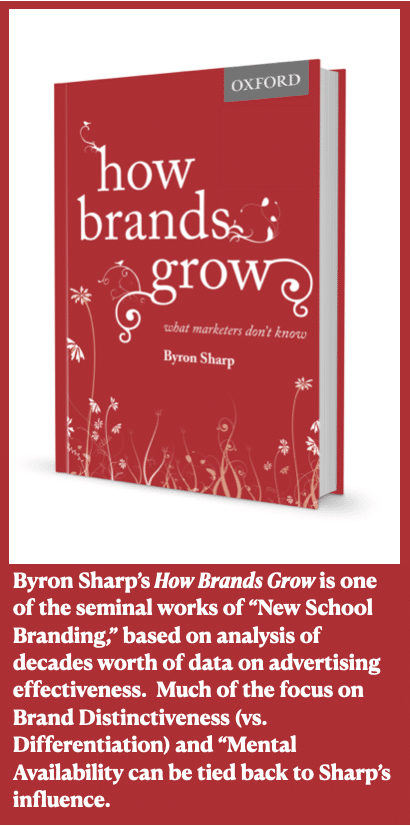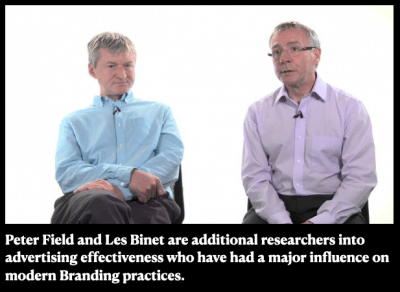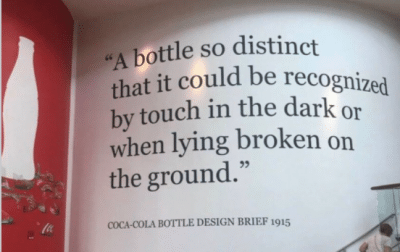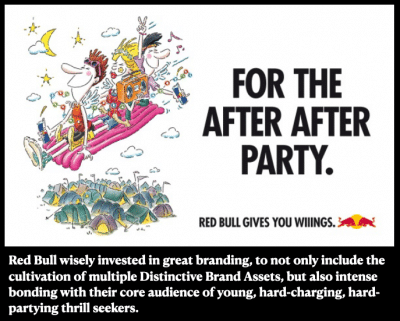In last week’s article, I wrote that the most important search engine is the one in your customers’ heads.
I also wrote that optimizing that search engine involves the deliberate creation and amplification of associations in the minds of customers.
Finally, I promised to share the down-and-dirty details for achieving success with this process.
So let’s start by looking at each key element in turn.

Creating a Rich Network of (Strong) Associations
This would seem to be a no-brainer, but it strongly contrasts with previous schools of branding.
Prior to relatively recent research and work done on branding effectiveness, it was largely presumed that Branding was best done with a sharp focus on associating the brand with a single, logical brand attribute or benefit.
If you’ve ever heard anyone babble on about a Unique Selling Proposition (USP), you’re likely familiar with this line of thought.
To give the canonical example, M&Ms created an exclusive association between their candy and the then-unique benefit of “Melts in your mouth, not in your hand.”
Obviously, though, one can’t create a network of associations by exclusively focusing on a single benefit. So that’s a problem.
 Worse, strong associations require sensory and emotional elements, which reason-why advertising typically lacks.
Worse, strong associations require sensory and emotional elements, which reason-why advertising typically lacks.
So the primary differences in New-School branding are an increased focus on:
- Developing multiple sensory brand cues, aka Distinctive Brand Assets
- Prioritizing emotional associations over reason-why differentiations
Let’s drill down on each of these in turn.
Distinctive Brand Assets
 As noted in last week’s post, mental associations work more powerfully when moving from the sensory and tangible to the emotional and conceptual.
As noted in last week’s post, mental associations work more powerfully when moving from the sensory and tangible to the emotional and conceptual.
Distinctive brand assets provide those sensory elements that are unique and distinctive to the brand, which helps enrich the network of mental associations embedded in consumers’ heads.
This can take the form of:
- A particular style of font, as Snicker’s uses for its packaging and print ads.
- Earwormy Audio cues like those used for “Intel Inside” and McDonald’s “I’m loving it”
- Brandable Chunks and jingles such as Tony the Tiger’s “They’re great,” The Jolly Green Giants “Ho, ho, ho,” or Chick-fil-A’s “My Pleasure”
- A visual or design element like the McDonald’s Golden Arches, Apple’s apple logo, or Absolut’s distinctively shaped bottle.
- Distinctive Color combinations or patterns like Burberry’s plaid or Coca-Cola’s red and white.
- Mascots and Spokesman like M&M’s mascots featured in all their ads.
Not only do these serve as cues to facilitate brand recall, but they help make the brand distinctive from competitors — not to mention more familiar and better liked.
And note that distinctive doesn’t mean differentiated. There’s no logical reason-why aspect to distinctive brand assets.
The M&M mascots don’t spout off “melts in your mouth, not in your hand” or even mention their “hard candy shell.” They simply engage in skit comedy with an eye towards being liked and culturally relevant.
Finally, note that modern branding employs multiple brand assets aimed at creating a network of associations.
Prioritizing emotional associations
As mentioned with M&Ms, sometimes it’s enough simply to be “liked,” even when customers like you for reasons having nothing to do with product effectiveness or benefits.
But why is that?
One reason is that most companies in most business categories are simply unable to sustain a true USP or product benefit.
If a difference or advantage proves decisive in winning customers, it’ll get copied ASAP by competitors who wish to stay in business, once again leveling the playing field.
 And just like the one-eyed king in the land of the blind, it is the distinctive and liked product that reigns over the land of the undifferentiated.
And just like the one-eyed king in the land of the blind, it is the distinctive and liked product that reigns over the land of the undifferentiated.
For example, Red Bull had a totally unique USP as the only “energy drink” on the market for a few years. Then the competition came rolling in to get a piece of that market.
Fortunately for Red Bull, they spent those first few years building brand distinction and likability with their core audience, so they remain the dominant player among a field of also-rans.
The second and perhaps even more important reason to prioritize emotional over logical associations is that emotional associations are strong associations.
What reason-why gains in relevance it loses in emotional power. And without emotion, a brand simply won’t colonize the unconscious of the buyer.
Bottom Line: it’s not just the number of links, or even the relevance of those links that matter, but the strength of those links.
Relational Associations and Fame
“Fame” is arguably one of the biggest drivers of ad campaign impact.
And according to modern researches on brand effectiveness, fame comes down to a brand, campaign, or ad becoming a cultural reference point.
For example, the 1980s advertising character Joe Isuzu became a cultural icon of insincerity that political candidates likened to their opponents.
And that makes Fame necessarily and inherently social — something that only comes into being through the interactions between people, media, and each other.
Meaning that a brand or a celebrity can’t be famous to a single person. It can only be famous within a community.
More pointedly, fame requires that customers know that others know.
Customers must know they can use references and allusions to your advertising and your branding when talking to others.
This is the super-power behind mass media advertising.
Mass media ads not only reach the masses, they also ensure that customers know that “everyone else” has seen or heard a given ad or campaign.
Of course, there IS a catch.
The catch is that no one will “know” that others have seen or heard your ads unless they are unignorable and high-impact.
If your ads sound like ads, they’ll fade into the background clutter of a media-saturated landscape, and you can kiss fame goodbye.
And aside from high-impact, what makes ads worth talking about and referencing?
What makes them gossip-worthy?
Ads that speak to our relational needs and values are gossip-worthy.
In other words, do people self-identify with the ads?
Can they see themselves as part of your tribe?
This is the reason why Bonding is so much more powerful than garden-variety branding.
And why Genesis Stories remain a go-to secret weapon for Wizard of Ads ad writers.
Dominating the Search Engine In Your Customer’s Head
And there you have it. The way to rank first in the most valuable search engine is to create and cultivate a rich network of mental associations linked to your brand.
And the way to do that is to focus on:
- Distinctive Brand Assets,
- Emotionally Powerful Associations, and
- The creation of Fame through Mass Media Advertising and Bonding.
If your ad team is doing that, you should be enjoying rapid growth.
If not, you should be considering a new ad team.
- Are You Paying for Too Much for the Wrong Keywords? - July 15, 2024
- Dominate Your Market Like Rolex — 4 Powerful Branding Lessons - July 3, 2024
- Military-Grade Persuasion for Your Branding - June 25, 2024
